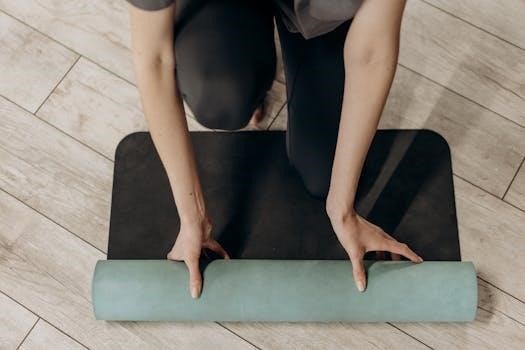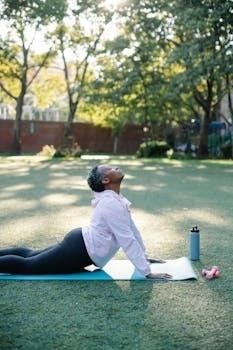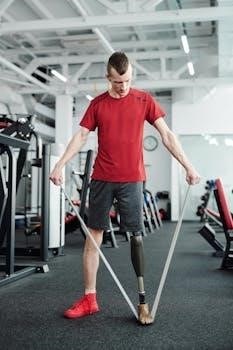full body mobility routine pdf
Full Body Mobility Routine PDF⁚ An Overview
This document provides a comprehensive overview of a full body mobility routine‚ designed to enhance your physical well-being through targeted exercises. It emphasizes daily practice and includes dynamic movements and active stretching techniques for improved flexibility.
Full body mobility is crucial for overall physical health and functionality‚ going beyond just flexibility. It encompasses the ability to move your joints through their full range of motion with control and ease. This introductory section emphasizes the importance of incorporating mobility work into your daily routine. Unlike simple stretching‚ mobility exercises focus on active movement‚ enhancing not just flexibility but also joint stability and strength. This approach helps in performing everyday tasks more efficiently and reducing the risk of injuries. A well-rounded mobility program involves exercises targeting various parts of the body‚ including the wrists‚ thoracic spine‚ hips‚ and glutes. It’s about training your body to move freely and effectively‚ leading to better overall physical performance. Consider this as foundational to your workouts‚ making all movement‚ even simple everyday movements‚ more effortless.
Benefits of Regular Mobility Workouts
Regular engagement in full body mobility workouts yields numerous benefits‚ extending beyond simple flexibility. Enhanced joint stability is a primary advantage‚ as mobility exercises strengthen the smaller muscles around joints. This provides better support and reduces the risk of injuries during daily activities and workouts. Moreover‚ improved range of motion allows for more efficient movement patterns‚ making everyday tasks easier and less taxing on the body. Regular mobility work can also decrease stress on the low back‚ neck‚ and shoulders by mobilizing the thoracic spine. Furthermore‚ it aids in enhancing overall athletic performance by allowing the body to move more freely and powerfully. Incorporating a mobility routine also helps in promoting better posture and balance‚ contributing to a greater sense of well-being. A consistent practice is key to experiencing these benefits‚ making it a valuable addition to any fitness regimen.

Key Components of a Full Body Mobility Routine
A comprehensive routine should include exercises for the wrists‚ thoracic spine‚ hips‚ and glutes. Dynamic movements and active stretching are also vital for improving flexibility.
Essential Exercises for Full Body Mobility
Incorporating a variety of movements is crucial for comprehensive mobility. This includes exercises such as wrist clock walks and reverse wrist push-ups‚ which enhance wrist flexibility and strength. Planche support to downward dog is also beneficial‚ promoting full-body engagement and spinal mobility. Focusing on dynamic movements helps prepare the body for various activities. It is important to also include stretches that target major muscle groups. Remember to perform each exercise with proper form to maximize benefits and prevent injuries. Aim for about 12 repetitions of each exercise‚ stopping if fatigue sets in. Regular practice is key to achieving noticeable improvements in overall mobility. These movements will aid in improving joint stability and assisting full-body movements.
Focus on Thoracic Spine Mobility
The thoracic spine‚ located in the upper and mid-back‚ plays a crucial role in overall mobility and posture. Addressing stiffness in this area is vital for reducing stress on the lower back‚ neck‚ and shoulders. Exercises such as thoracic rotations and cat-cow stretches are particularly effective. These movements help to increase the range of motion in the upper back. It is beneficial to incorporate dynamic stretches‚ which enhance flexibility and improve the ability to move freely. Prioritizing thoracic spine mobility can lead to better posture‚ reduced pain‚ and improved athletic performance. It is essential to perform these exercises with control and proper technique to avoid any strain or injury. Consistency is key for long-term benefits. Regular focus will contribute to a healthier and more mobile spine.
Importance of Hip and Glute Mobility
Hip and glute mobility are fundamental for overall functional movement and stability. Improving mobility in these areas can lead to increased range of motion‚ reduced risk of injury‚ and enhanced athletic performance. Tight hips and glutes often contribute to lower back pain and discomfort in other areas of the body. Incorporating exercises such as hip circles‚ glute bridges‚ and figure-four stretches can significantly improve mobility. These movements assist in strengthening the muscles surrounding the hips and glutes‚ promoting better joint function and movement patterns. Regular practice of hip and glute mobility exercises is crucial for maintaining healthy movement and preventing imbalances. A focus on these areas is important for achieving a balanced and functional body‚ supporting daily activities and athletic pursuits alike. Improved hip and glute mobility also aids in enhancing overall body mechanics.

Implementing Your Mobility Routine
Integrating mobility work into your daily life is essential for achieving optimal benefits. Consistency and proper timing are key components for a successful routine‚ maximizing results and preventing injuries.
Frequency and Timing of Mobility Work
Determining the optimal frequency and timing for mobility work is crucial for maximizing its benefits. For individuals aiming to improve their range of motion and flexibility‚ daily mobility exercises are recommended‚ integrating them seamlessly into your schedule. Aim to complete a full routine at least once each day‚ or break it down into individual exercises throughout the day‚ but ensure every exercise is completed daily. The best time to do mobility work can vary; some prefer it as a morning routine to prepare for the day‚ while others find it beneficial after workouts to aid recovery‚ or before workouts to prepare the body for the movement that’s about to come. Consistency is key‚ and even a few minutes of daily mobility work can significantly improve overall physical well-being and help prevent injuries associated with inflexibility. It’s important to listen to your body and adapt your routine as needed to suit individual needs and goals‚ finding a schedule that suits your specific lifestyle.
Daily Practice Recommendations
For optimal results‚ incorporating a daily mobility practice is highly encouraged. The goal is to consistently engage in exercises that target all major joints and muscle groups; It’s recommended to aim for a full body routine at least once per day. You can perform the entire sequence at once‚ or break it into smaller segments if that fits your schedule better‚ but make sure to complete all exercises every day. A daily practice could include a combination of dynamic stretches‚ active stretches‚ and movements focusing on the thoracic spine‚ hips‚ and wrists. It’s also beneficial to include exercises that promote joint stability and assist in full-body movements. Pay close attention to your body’s signals; if you feel a particular muscle group fatigue‚ stop before completing all repetitions. Consistency is more important than intensity‚ so focus on maintaining a daily practice‚ even if it’s just for a few minutes each time.
Integrating Mobility with Other Workouts
Mobility work should not be viewed as a separate entity but rather as an integral part of your overall fitness regimen. Integrating it with your other workouts can significantly enhance their effectiveness and minimize the risk of injury. Before engaging in any intense physical activity‚ prioritize dynamic mobility exercises to prepare your body. These could include movements like walking lunges to warm up the muscles. Following your workout‚ incorporate a static stretching series to promote recovery and improve flexibility. Consider a 4-6 minute total body static stretching routine. By strategically adding mobility exercises before and after workouts‚ you are actively promoting better joint health‚ muscle function‚ and overall movement quality. Remember‚ mobility is key for functional fitness‚ therefore this integration is essential for a well rounded exercise plan and will result in better performance‚ and injury prevention.

Specific Exercises and Techniques
This section will delve into specific exercises‚ including wrist mobility movements like clock walks and reverse push-ups. We will explore dynamic flexibility movements and active stretching techniques to improve your overall mobility.
Wrist Mobility Exercises
Wrist mobility is crucial for various daily activities and exercises. Incorporating specific wrist exercises into your routine can significantly improve joint health and prevent injuries. A great starting point is wrist clock walks‚ where you move your wrists in a circular motion‚ mimicking the hands of a clock. These can be performed in both directions to ensure comprehensive mobility. Another effective exercise is reverse wrist push-ups‚ which help to strengthen and stretch the muscles surrounding the wrist joint. These exercises are especially beneficial for those who spend extended periods typing or performing repetitive hand movements. Remember to perform these movements with controlled and gentle motions‚ focusing on the range of motion rather than the speed. This will help to increase your wrist’s overall flexibility and reduce the risk of strain or pain. Consistency is key for optimal results.
Dynamic Movements for Flexibility
Dynamic movements are essential for enhancing flexibility and preparing the body for physical activity. These movements involve controlled motion through a range of joint movements‚ promoting blood flow and muscle activation. Examples include walking lunges‚ which improve hip and leg flexibility while engaging multiple muscle groups. Another effective dynamic movement is the arm circle‚ focusing on shoulder and upper back mobility. These movements should be performed gently‚ gradually increasing the range of motion as your body warms up. Unlike static stretches‚ dynamic movements actively engage your muscles‚ improving joint mobility and overall flexibility. Integrating dynamic stretches into your routine can enhance performance and reduce the risk of injuries‚ making them an invaluable part of a full body mobility program. Remember to maintain control and focus on smooth‚ fluid movements.
Active Stretching Techniques
Active stretching techniques involve engaging your muscles to achieve a stretch‚ rather than relying solely on external force. This method enhances flexibility and improves muscle strength and control. A prime example is using opposing muscle groups to deepen a stretch‚ like pulling your toes up towards your shin to increase the stretch in your calf. Active stretches encourage improved range of motion and body awareness. Techniques like PNF contractions‚ which involve contracting the target muscle before stretching it‚ can be highly effective in improving mobility. Incorporating active stretching as part of your daily routine can significantly improve joint flexibility and overall body movement‚ contributing to a more functional and injury-resistant body. Remember to perform each movement with control and focus‚ avoiding sudden or jerky motions.

Additional Considerations
This section delves into injury prevention through mobility‚ the connection between functional fitness and mobility‚ and the distinctions between mobility and flexibility. It highlights their importance for a well-rounded fitness approach.
Preventing Injuries through Mobility
Engaging in regular full-body mobility workouts is crucial for injury prevention. These routines enhance joint stability‚ particularly in smaller muscles that assist in larger movements. By improving the range of motion and flexibility‚ you reduce the stress placed on joints‚ decreasing the likelihood of strains and sprains. A focus on areas like the thoracic spine‚ hips‚ and glutes is particularly important‚ as mobility in these regions can alleviate stress in the lower back‚ neck‚ and shoulders. Consistent mobility work helps to bulletproof the body‚ making it more resilient to daily activities and intense workouts. Incorporating these exercises into your routine promotes a healthier‚ more functional body‚ minimizing the risk of injury during both exercise and everyday life. The key is a proactive approach to mobility‚ making it a foundational element of your fitness plan.
Functional Fitness and Mobility
Functional fitness and mobility are intrinsically linked‚ focusing on exercises that mimic everyday tasks‚ thereby enhancing muscle strength‚ coordination‚ balance‚ and overall flexibility. Mobility exercises‚ when integrated into a functional fitness program‚ allow for better execution of daily movements‚ promoting efficiency and reducing the risk of injury. Incorporating mobility work alongside functional training is essential for developing a well-rounded fitness approach. This combination ensures that your body not only gains strength and power but also has the flexibility and range of motion needed to perform these movements safely and effectively. It emphasizes the importance of moving well‚ not just moving powerfully‚ creating a holistic approach to fitness that improves both performance and quality of life. The goal is to create a body that is both strong and adaptable to any challenge.
Mobility vs Flexibility
While often used interchangeably‚ mobility and flexibility are distinct concepts. Flexibility refers to the ability of a muscle to lengthen passively‚ whereas mobility encompasses the ability to move a joint through its full range of motion actively. Flexibility is a component of mobility but doesn’t guarantee it. A person can be flexible but lack the strength and control to utilize that range effectively‚ making true mobility essential. Mobility requires a combination of flexibility‚ strength‚ and coordination‚ which is why mobility exercises are often active‚ engaging muscles to move joints through their full potential. Focusing on mobility improves not only range of motion but also stability and control‚ which can greatly enhance overall functional movement and reduce the risk of injuries. Therefore‚ a holistic approach includes both components.